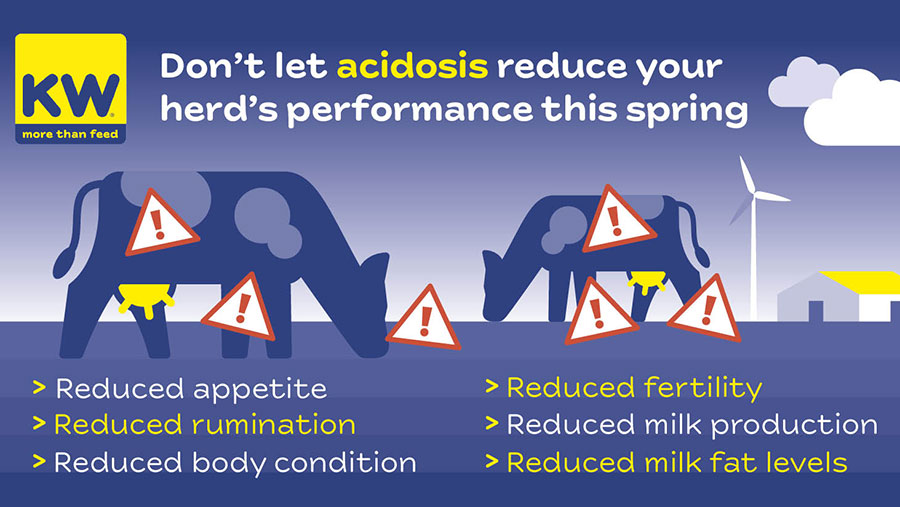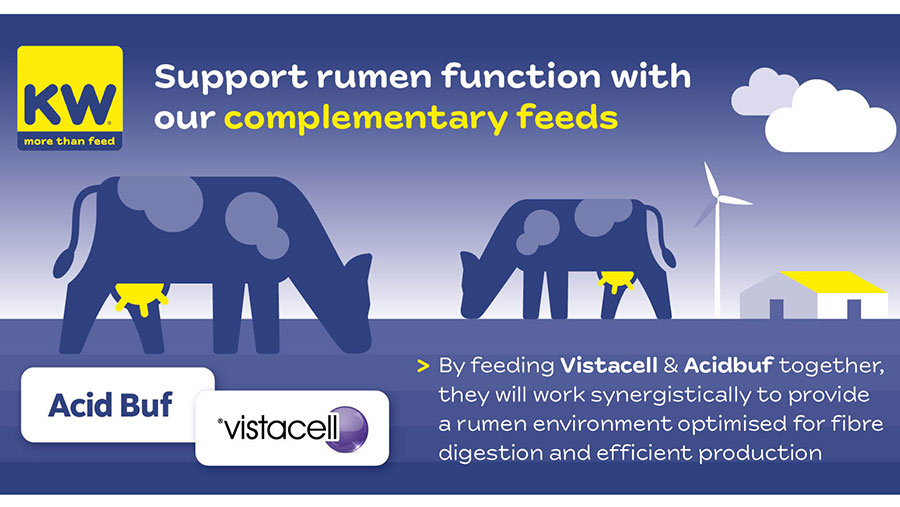Advertiser content
Acidosis at turnout a major threat to profitability
 © KW Feeds
© KW Feeds Volatile world feed markets and milk price drops mean many dairy farmers are looking to turnout to make the most of grazed grass to help save costs.
Feeding cows at grass provides a welcome opportunity to reduce feed costs and the carbon footprint of the ration, but introduces a different series of challenges, not least estimating grass nutritional value and supply.
Failing to correctly balance the nutrient supply from grazing and prevent sub-acute ruminal acidosis (SARA) at turnout can cut feed intakes by 5% or more, potentially reducing daily milk yields by up to 2.5 litres/cow, claims KW nutritionist Charlotte Ward.
“For cows that get turned out, fresh grass is the cheapest feed available, and making the most of that value is the key to maximising income over feed costs (IOFC) during the grazing season,” she states.
“But any disruption to rumen fermentation will undermine feed conversion efficiency, cut butterfat production and reduce milk from forage. Avoiding SARA and maintaining good rumen function, and particularly fibre digestion to support milk fat synthesis, therefore needs to be a top priority.”
Impact of SARA
The effects of SARA are seen whenever the rumen drops below the optimum pH5.8-6.2 for a period of 2-3 hours or more. The result is a substantial reduction in the activity of fibre digesting microbes, reducing both effective digestion of fibre and, ultimately, grass utilisation.
“These fibre digesting microbes are also highly sensitive to even the smallest amounts of oxygen, so this reduction in activity – and often destruction of the microbes – is compounded by the natural and unavoidable intake of air with every mouthful of grass,” Ms Ward continues.
“It’s one of the reasons why feeding grazing cows Vistacell live yeast to ‘mop up’ that oxygen can have such a positive impact on cow performance, particularly when used alongside a slow-release rumen conditioner like Acid Buf to help maintain optimum rumen pH.”
In addition to a drop-off in cow performance, other symptoms of SARA can include undigested feed in the manure, increased diarrhoea and manure that is foamy in appearance.
In more severe cases, there may be a reduction in eating times, with cows quick to lie down, plus a cycling between days of good intake followed by periods of poor intake.
Building the buffer
“Even the best quality swards grazed under good conditions will only realistically deliver maintenance plus 15-20 litres/cow, so it’s essential none of this is lost to SARA,” Ms Ward highlights.
“The key is to correctly balance grass intake with the right type and amount of complementary feeds to maximise efficiency and fully support both milk output and body condition.”
Ms Ward recommends starting with 8-15kg FW/cow of good quality silage, plus 0.5-1.0kg FW/cow of ‘muzzle width’ chopped straw to provide the structural fibre needed for good rumen function.
Maize or wholecrop cereal silages are ideal to include as both contain the types of fibre lacking in spring grazing, as well as starch to help utilise the high levels of rumen protein in fresh grass.
“Adding 1-2kg FW/cow of feeds high in digestible fibre such as sugar beet feed or soya hulls will reduce the build-up of acid that leads to SARA, as well as supplying the much-needed building blocks for milk fat that are missing from spring grass,” she adds.
Actual buffer feed formulation will depend heavily on both production targets and the available feeds that offer best value.
If milk supply contracts have a minimum butterfat threshold, it’s often worth including a high-C16 rumen-protected fat like Butterfat Extra to further protect milk value, Ms Ward explains.
Balancing nutrient release
“The starch and protein feeds included in the buffer also need to be considered carefully,” she continues.
“Starch is important in supporting yields and milk protein content, even when cows are grazing, so select feeds with a slower rate of starch release such as caustic sodawheat or ground maize rather than rolled or ground cereals, to lower acid loading in the rumen.”
The predominantly rumen degradable protein in spring grass also needs to be balanced, in this case with feeds high in rumen-bypass protein, otherwise known as digestible undegraded protein (DUP). Good examples include dedicated DUP supplements such as NovaPro rumen-protected rapeseed expeller.
Grazing and grass-silage based rations often over-supply crude protein to the animal, leading to expensive protein being wasted and increased nitrogen pollution on farm.
NovaPro enables the metabolisable protein requirements to be met in these rations without over-supplying crude protein which can help to lower Milk Urea Nitrogen levels (MUN).
Lower MUN levels support lower ammonia and nitrous oxide emissions and improved fertility.
Understanding the protein required to balance your ration whilst ensuring crude protein is not over-supplied can lead to a cost saving on farm and benefits in terms of the environment and fertility.
“With careful management and monitoring of grazed grass and supply of a high-quality, well balanced buffer ration, producers can expect to maximise utilisation of grazed grass, limit production losses and improve overall lactation profit,” concludes Ms Ward.

© KW Feeds
Provided by
At KW, we’re proud to support our customers to achieve sustainable performance through unrivalled market expertise and a product offering second to none. We pride ourselves on being a feed and nutritional services partner to some of Britain’s top-performing farms.
